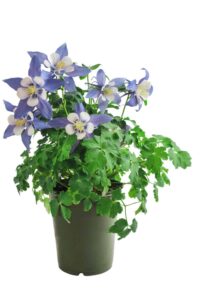Delicate and lovely columbine flowers are an easy-care plant that returns each year to our perennial garden. For maximum success with columbines, it’s essential to know which plants make good columbine companions. Get some great columbine companion plant ideas here, as well as tips about how to grow columbine plants in locations where they will thrive. Wondering about the best columbine companion plants? You’re in the right place as I share lessons learned from multiple decades of experience with growing this beautiful flower, one of the best zone 8 perennial plants. Learn what to grow with columbine, as well as when to plant columbine and how to plant columbine for maximum success. Read on for some great plant combination ideas to use with the columbine plant family, Aquilegia.

Table of Contents
My Columbine Backstory
Years ago, when my husband and I were first married, we lived in a little cabin near a river east of Portland, Oregon. It was very shady, but a previous tenant had planted columbines, and they thrived in the dappled sunlight. We would sometimes take hikes down to the river and would come upon wild columbines that were a different color than the bluish-purple ones we had growing in our yard. They were a beautiful part of the forest landscape.
Later, when we moved into our current home, we planted columbines in our partially-shaded front flower beds. They thrived there as well, but grew too close to the front walkway, leaned over it and blocked the path. After some digging, we transplanted a few to our current perennial garden in the backyard. They continue to thrive in the partial shade, and now pose no risk of getting in the way of a garden path. They are very low-maintenance, deer-resistant (find it on my list of deer-resistant flowers), and give us pleasure during the early weeks of summer.
This post contains affiliate links, which means I may earn a small commission from qualifying purchases at no additional cost to you. Please read my Policies page for more information.
Types of Columbine Flowers
Columbine are otherwise known as Aquilegia or Granny’s Bonnet (love that name). According to various sources, there are approximately 70 varieties of columbine. Some of the most common are the Blue Barlow (double-bloomed and excellent for cut flower arrangements), the wild Western columbine (I now know these are the type of columbine we saw on our river hikes), and the Alpine columbine.

Where to Plant Columbine
Where should I plant my columbine in my garden?
Columbine does best in soil that is well-drained but not too dry. If you live in a warm climate, a nice layer of mulch will help the soil retain moisture. We have grown columbine in our USDA plant hardiness zone 8b yard in varying conditions over the last three decades. Does columbine like sun or shade? We first grew them, as noted above, in a mostly shady yard. They were well-established by the time we became tenants, so we did nothing to them. They came back reliably every year, and were a perfect fit for our Oregon cottage garden. At that point in my life, I knew nothing about plants. I’m grateful to the person who planted the columbine in the first place, along with bluebells other easy-care perennials.
We have also grown columbine in a location that received direct morning sunlight but was shaded in the afternoon. They did so well we had to move them, as they were crowding the front walkway. Now we have moved them to our perennial garden in the backyard, where they receive a few hours of afternoon sunlight, but are shaded the rest of the day.
If you live in a warm climate, partial shade is better than direct sunlight. If you live in colder, alpine climates, columbine can thrive in full sun. If you have a perennial garden, it’s nice to place columbine with other tall plants so you don’t have to worry about the columbine plants leaning over. That brings us to the best companion plants for columbine.
When to Plant Columbine
Columbines (Aquilegia) are best planted either in the fall or early spring. The exact timing can depend on your local climate and growing conditions. Here are guidelines for both planting seasons:
Fall Planting:
In regions with mild climates, planting columbines in the fall allows them to establish their root systems before winter.
Aim to plant columbines at least 6-8 weeks before the first expected frost date. This allows the plants to acclimate and develop roots before winter dormancy.
Spring Planting:
In colder regions, where winters are harsh, spring planting after the last frost is a suitable option.
Plant columbines in early spring, once the soil can be worked and temperatures begin to rise.
Provide adequate water after planting to help the columbines establish in their new location.
Best Columbine (Aquilegia) Companion Plants: What to Plant With Columbine
What grows well with columbine?
In our perennial garden, we have columbine located next to a bleeding heart plant (Lamprocapnos spectabilis) that comes back reliably every year. It has a nice tall structure that makes a good support for the columbine if it starts to lean over. I love the little heart-shaped blossoms on this hardy plant. Other good companion plants for columbine include alchemilla, campanula, ferns, phlox and pulmonaria (an all-time favorite on my list of best easy-care perennials to grow). Columbine plants also do well with allium, daylilies, foxglove heuchera, iris, and poppies. For easy reference, here is a chart. Nearly all of the plants on the list are perennials except foxglove and hollyhock, which blooms the second year, then produces seeds and dies. Although there are some perennial varieties of foxglove, they are traditionally biennials. Looking for wild columbine companion plants? The columbine flower companion plants on this list would work well. If you are going for a wild theme, you might want to try to find some wild iris, or blue flag. We have many in our rural location outside of Portland, Oregon.

| Best Columbine Companion Plants |
| Perennials |
| Alchemilla (Lady’s Mantle) |
| Allium (bulbous perennial) |
| Campanula (Bellflower, bluebells) |
| Daylily |
| Dicentra (Bleeding Heart) |
| Fern |
| Heuchera (Coral bells) |
| Iris |
| Phlox |
| Poppy (perennial varieties) |
| Pulmonaria (Lungwort) |
| Biennials |
| Foxglove |
| Hollyhock |
How to Propagate Columbine
Does columbine spread easily?
Established columbine may be divided with care, but the easiest way to get more columbine plants is to collect the seeds. You can store the columbine seeds in the refrigerator over the winter for springtime planting. When planting columbine seeds, space the seeds at least 1 foot apart once all danger of frost has passed in the spring or early summer. If you can add a top dressing of compost or manure and work it into the soil, that will keep the columbine blooming well. You can also add mulch to keep the soil evenly moist.
Are you wondering when to plant bare root columbine (some might think of them as bulbs)? If you have bare root columbine or columbine in a pot, the best times to plant are in the early spring or early fall. Whenever you choose to plant, it’s best to amend the soil. In addition to compost or manure, you can add a water-soluble fertilizer every month to keep the blooms looking bright.
Do columbine plants spread too much? Once they have an established root system, columbine can be difficult to dig up. It is possible to remove columbine from an area (like our front walkway), but it does take time and effort. If you think you have enough columbine in your yard but want to give the seeds away, just tie a paper bag over the top of the blossoms before they drop their seed. Are columbine flowers invasive? No, columbine are classified as non-invasive, but you may have to move them if they start draping over things, as was the case with our front walkway.
Should you let a columbine self-seed? Most columbine plants will only last for about three years, so letting them self-seed is a good idea if you like having them in your garden. Once they are established, you can have columbine plants for years to come.
How to Care for Columbine
When columbine plants are first put in the ground, the soil should be kept moist. Once the plants become established, a weekly watering is all they need. Some people like to deadhead columbine plants to encourage additional blooms. Wondering how to deadhead columbine flowers? Just cut off the blossom and discard. Most columbine plants will bloom for about four weeks. Once the blooms are spent, you can cut off the flower stems and just leave the foliage. As the season progresses into fall, the foliage may change to an interesting red color. If you are concerned about columbine self-seeding, then you can cut the columbine back all the way to the ground in the fall. If self-seeding is not a concern, then it’s fine to leave the foliage intact to overwinter.
Adding Columbine to Your Garden Design
As with many plants, the columbine plant height and width will vary with the species. Most columbine range in height from 1-3 feet, with a width of about 18 inches. Due to our previous experience with columbine leaning over our sidewalk, I would suggest planting columbine in the center of a perennial garden, not on the edge. That way, it could be supported by other plants as it blooms and grows taller. Depending upon the design of your garden, this might mean planting in the second row or even the back if you have a perennial garden located along the side of a building.
Growing Columbine in Containers
Columbine can make a good outdoor container plant if desired. Just sow seeds directly into a pot filled with potting soil and lightly cover with more potting soil. Columbine plants in containers do best outdoors, and the soil should be well-drained. Since it is a tall plant, it would make a good “thriller” in the center of a garden container, using the traditional “thriller, filler, spiller” container planting method.

Can columbine be grown indoors? Yes, but the likelihood of it producing blooms is slim. You could start a columbine plant indoors, then move it outdoors when the weather warms up.
Columbine Pollinators and Pests
What pollinators do columbines attract?
If you have a red or yellow variety of columbine, hummingbirds will be attracted to the blossom nectar. Columbine also attract butterflies and bees.
Which pests target columbine?
There are two types of pests that target columbine, mainly affecting the leaves but not the overall plant health. Columbine leafminers produce white trails along the leaves of the plant. Since the damage is usually superficial, the best approach to dealing with this pest is to pick off the affected leaves and discard. The other type of columbine pest is the columbine sawfly, which feeds on the leaves. The best way combat this pest is by picking off the larvae and placing into soapy water or by treating the leaves with insecticidal soap. According to the University of Wisconsin Horticultural Extension website, the columbine sawfly is found mainly in New York and Minnesota (far away from our Oregon garden). If you have repeated problems with these columbine pests, you can replace hybrid columbine plants with the less-susceptible native columbine, Aquilegia canadensis.
Other Questions About Columbine
Are columbines perennials?
Yes, columbines are perennial plants, which means that they should return every year to bloom in in spring and early summer. With proper care, you will be able to enjoy columbine plants for years to come.
Are columbine plants invasive?
While columbine is not typically considered highly invasive, some species and varieties of columbines have the potential to self-seed and spread, leading to their naturalization in certain areas. The extent of self-seeding can vary among different columbine species and cultivars. Deadheading (removing spent flowers) before seed formation can help control self-seeding if you are concerned about the spread of your columbine plants
Columbine Gift Ideas
Are you enamored with all things columbine? Maybe you know someone who is a huge columbine fan. Here are some fun gift ideas for the columbine lover in your life, starting with an attractive columbine garden journal.
Not sure where to get columbine seeds? Here are some of the blue columbine variety, ready to be planted.
Perhaps some printable columbine wall art is more to your taste, like this 8 by 10-inch botanical columbine print.
Proclaim you are a columbine fan with this columbine-decorated floral tote bag made of sturdy, canvas-like fabric.
Other Companion Planting Ideas
Get other winning planting combinations by learning about the best companion plants for rosemary, eggplant, rhubarb, lavender, sunflowers, hydrangeas, raspberries, lemongrass, hostas, and pumpkin. Make the most of whatever garden space you have by arranging plants that grow well together. Learn about plants that have similar growing conditions so your garden can thrive.
Keep Track of Your Garden with a Journal Logbook
To keep track of your planting ideas, goals, and plans, you can use a printable free garden journal logbook. Choose the pages you want to print and customize them as you wish to record monthly, weekly, and daily garden tasks, lists, weather, and planting arrangements. There are also grid pages for easily designing the layout of your vegetable garden, flower garden, or landscape. Print it out and put it into a notebook you can take with you to the garden (that’s what I do). It’s nice to have all of your garden information in one place.
Planting a Perennial Garden?
Now that you know which plants make good companion plants for columbine, you can create your own interactive garden planner. Short on time? I have one ready for you. It’s perfect for planning the layout of a perennial garden or any other type of garden space,

It’s fully customizable when you make your own copy and includes two editable chart pages for noting planting specifications. You can easily arrange, then rearrange the plants as much as you like.
Get my free online garden layout planner template!
Organize Your Garden Tasks with a Free Garden Planner Notebook
As a result of needing to keep track of garden tasks throughout the year, I decided to begin a garden planner notebook. It has a page for each month, along with notes pages. If a garden planner notebook seems like a good idea to you, good news! You can get it here!
Get the garden notebook!
Have a wonderful week, and may all of your columbine companion planting endeavors meet with great success!

Lisa Mitchell is a wife, mom, and school librarian who likes to grow fruit, vegetables, and flowers on her family’s small Oregon farm, located outside of Portland. To learn more about what this website has to offer gardeners, click on over to the Garden page.
Like what you read here? Please give it a share, and you may also be interested in reading about the best rhubarb companion plants, the best chives companion plants, the best pumpkin companion plants, and the best companion plants for eggplant.
Want more great garden, food, or travel ideas? Follow FluxingWell on Pinterest, Facebook, Instagram, and X for the latest posts, tips, and inspiration.







They are so beautiful! I wish I could grow them here in 10b! Even though we have a shady part of the yard, I still think it would be too hot for these beauties. Great article explaining the care and companion plants for Columbines.
Thank you! Yes, I imagine 10b would not be the friendliest environment for columbines, but I envy you your citrus and avocados.=)
It’s nice to know the other plants that make good columbine companion plants. This is a pretty plant to have around.
Yes, columbine is lovely and a reliable bloomer.